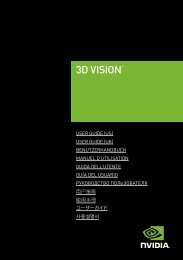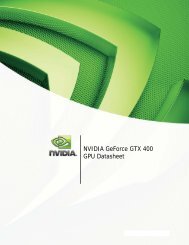Tegra 4 Whitepaper - Nvidia
Tegra 4 Whitepaper - Nvidia
Tegra 4 Whitepaper - Nvidia
- No tags were found...
Create successful ePaper yourself
Turn your PDF publications into a flip-book with our unique Google optimized e-Paper software.
P a g e | 7blended with existing framebuffer pixel information, or they can overwrite the current framebufferpixel data.GPU Pipeline Implementation DetailsWe will discuss the NVIDIA ® <strong>Tegra</strong> ® 4 processor’s GPU physical pipeline below and refer to<strong>Tegra</strong> 4 processor, but many of the general descriptions, aside from unit counts, apply to the<strong>Tegra</strong> 4i processor as well. The <strong>Tegra</strong> 4 processor’s GPU Architecture Diagram below (Figure3) presents more details on the actual physical implementation of the <strong>Tegra</strong> 4 processor’s GPUsubsystem.Starting from the top, rendering commands are fetched through Host/Front End units (notshown). Next, indices and vertices are fetched directly from memory and cached by the IDXunit. IDX then passes vertices to multiple Vertex Processing Engines (VPEs). The IDX unit alsosupports DX9-level instancing, where a single draw command can make multiple instances of amodel, with each model using a different set of per-instance data.Figure 3 – <strong>Tegra</strong> 4 GPU Architecture DiagramVertex Processing EnginesVertices are processed by six VPE units in the <strong>Tegra</strong> 4 processor’s GPU, each including aVEC4 ALU (arithmetic logic unit) that contains four MAD (Multiply-Add) units (where MAD unitsare more commonly known as Vertex Cores). <strong>Tegra</strong> 4 processor includes a total of 24 vertexcores which is 6x the number of vertex cores in the <strong>Tegra</strong> 3 processor. A 96-entry Vertex BufferNVIDIA <strong>Tegra</strong> 4 GPU Architecture February 2013
















